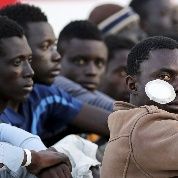The Mediterranean’s worst migrant boat disaster in decades has spurred a flurry of controversy over how to best handle the influx of displaced people trying to reach Europe. At least 800 migrants died on April 19 when their overcrowded boat capsized off the Libyan coast. The shocking tragedy doubled this year's current death toll for migrants in the Mediterranean, which now sits at around 1,500 – 10 times the number of deaths for the same time last year.

Some people have blamed the rising deaths on rising numbers of migrants making the perilous journey from North Africa to the Italian coast, but those people clearly haven't looked at the facts. According to the International Organization for Migration (IOM), since the start of the year, between 23,000 and 24,000 migrants have tried to cross the sea to Italy. Comparatively, just under 21,000 migrants made the same journey between January and April of 2014. In other words, migrant numbers are up slightly, but migrant drownings have skyrocketed.
If European nations didn't want people smugglers and refugees in Libya, then maybe they shouldn't have bombed the country to rubble.
Human rights groups have mostly blamed reduced search-and-rescue operations for the spike in deaths. In October 2014, the Italian government suspended its comprehensive search-and-rescue program known as Operation Mare Nostrum. Rome said it simply couldn't afford to keep the program afloat and argued other European Union nations should pick up the slack. Since then, the EU's border control agency, Frontex, has mounted Operation Triton. While Triton has a similar search-and-rescue mandate to the now defunct Mare Nostrum, it has less than one-third of the budget, and can only operate within 50 km of the Italian coast – meaning it is effectively powerless to aid migrant boats in distress on the high seas. In short, European indifference kills migrants.
The same could be said not only for the recent spike in drownings, but also to the broader issue of migrants making the dangerous crossing from North Africa in the first place. Many migrant boats take essentially the same route from Libya to Italy – the shortest maritime crossing in the central Mediterranean. Yet Libya hasn't always been a port for migrant boats. Rather, in recent years people smugglers have taken advantage of the collapse of the Libyan state since the 2011 NATO intervention that led to the overthrow of former head of state Moammar Gadhafi. A lawless, failed state with no control over its own borders is the perfect place for people smugglers to open up shop. If European nations didn't want people smugglers and refugees from Libya, then maybe they shouldn't have bombed the country to rubble, while arming the most ruthless militias so they could fight over the scraps. What other outcome could they possibly have expected? You can't stitch a divided nation back together with cruise missiles, and you can't promote peace by giving everyone a machine gun.
Yet most migrants crossing the Mediterranean aren't Libyans – they're from Syria, Somalia and Eritrea. One thing you may immediately notice is that all three of these countries face serious internal crises that have been exacerbated by Western interference. Like Libya, the West has shown a total disinterest in promoting any kind of negotiated peace plan in Syria; instead, the United States has led a campaign of bombing the country to rubble, and arming the most ruthless militias so they can fight over the scraps (sound familiar?).
Meanwhile, the seemingly endless conflict in Somalia can be traced back to the chaos caused by the IMF structural adjustment program forced on the country by the U.S. puppet dictator Siad Barre. For decades Barre was Africa's worst human rights abuser, but he enjoyed support from Washington as a bulwark against Soviet influence on the continent. However, as the Cold War came to a close in the late 1980s, Washington increasingly lost interest in propping up Barre's regime, and eventually he was overthrown and the country descended into a pit of chaos. This arrangement worked out fairly well for all the regional powers involved: Kenya and Ethiopia were able to expand their geopolitical interests.
The West also had a hand in ensuring Eritrea became one of the poorest countries in the world. From 1961 until 1991, Ethiopia fought a bitter war to maintain its occupation of Eritrea. First Ethiopia enjoyed U.S. support, and then later Soviet backing. Like Somalia's conflict, Ethiopia's war was fueled by the larger, cynical chess geopolitical game being played by the United States and USSR for control of Africa.
In Libya, Syria, Somalia and Eritrea, for decades Europe and the broader Western world have had a simple choice: support peace or encourage conflict. In all four cases, the Western world has been the unequivocal ally of war, suffering and abuse of basic human rights. Now that these countries have been sufficiently pillaged, the refugees produced by these Western-backed conflicts are left to drown at sea by the EU.
Policymakers can blame people smugglers, and can talk all they like about fortress Europe. But in the end, the only way to stop the boats is for the West to stop supporting war and oppression. They could start by treating these refugees in the Mediterranean humanely, instead of with the loathing Europe has shown Africa and the Middle East over the past century.